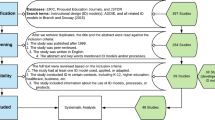Abstract
This is a report of one case of a design and development research study that aimed to validate an overlay instructional design model incorporating the theory of multiple intelligences into instructional systems design. After design and expert review model validation, The Multiple Intelligence (MI) Design Model, used with an Instructional Systems Design (ISD) Model, was tested for use by four practicing instructional designers. Instruction developed for learners using this model was then evaluated measuring post-test and attitudinal scores with 102 participants. This report also provides a reflection on the lessons learned in conducting design and development research on model validation. The procedures and findings have implications for the processes involved in instructional design model validation through designer use and program implementation.



Similar content being viewed by others
References
Armstrong, T. (1999). 7 kinds of smart: Identifying and developing your multiple intelligences. New York: New American Library.
Atkinson, J. W. (1974). The mainsprings of achievement-oriented activity. In J. W. Atkinson & J. O. Raynor (Eds.), Motivation and achievement (pp. 193–218). Washington DC: Winston.
Dick, W., Carey, L., & Carey, J. O. (2001). The systematic design of instruction (5th ed.). New York: Addison-Wesley Educational Publishers.
Edmonds, G. S., Branch, R. C., & Mukherjee, P. (1994). A conceptual framework for comparing ID models. Educational Technology Research and Development, 42(4), 55–72.
Forsyth, J. E. (1998). The construction and validation of a model for the design of community-based train-the-trainer instruction. (Doctoral dissertations, Wayne State University, 1997). Dissertation Abstracts International-A, 58(11), 4242.
Gagné, R. M., Wager, W. W., Goals, K. C., & Keller, J. M. (2005). Principles of instructional design (5th ed.). CA: Wadsworth/Thomson Learning, Publishers.
Gardner, H. (1983). Frames of mind. The theory of multiple intelligences. New York: Basic Books.
Gardner, H., & Hatch, T. (1989). Multiple intelligences go to school: Educational implications of the theory of MI. Educational Researcher, 18(8), 4–9.
Grabinger, R. S. (1996). Rich environments for active learning. In D. H. Jonassen (Ed.), Handbook of research for educational communications and technology (pp. 665–692). New York: Simon & Schuster Macmillan.
Gustafson, K. L., & Branch, R. M. (2002). Survey of instructional development models (4th ed.). New York: ERIC Clearinghouse on Information and Technology, Syracuse.
Keller, J. M. (1987). Development and use of the ARCS model of motivational design. Journal of Instructional Development, 10(3), 2–10.
LeMaistre, C. (1998). What is an expert instructional designer? Evidence of expert performance during formative evaluation. Educational Technology Research and Development, 46(3), 21–36.
Lindvall, R. (1995). Addressing multiple intelligences and learning styles: Creating active learners. Doctoral dissertation, Saint Xavier University, Illinois.
McAleese, R. (1988). Design and authoring: a model of cognitive processes. In H. Mathias, N. Rushby, & R. Budgett (Eds.), Designing new systems for learning (pp. 118–26). New York: Nichols.
Mory, E. H. (2004). Feedback research revisited. In D. H. Jonassen (Ed.), Handbook of research for educational communications and technology (2nd ed., pp. 745–783). New York: Simon & Schuster Macmillan.
Richey, R. C. (1998). The pursuit of useable knowledge in instructional technology. Technology Research and Development, 46(4), 7–22.
Richey, R. C. (2005). Validating instructional design and development models. In J. M. Spector & D. A. Wiley (Eds.), Innovations in instructional technology: Essays in honor of M. David Merrill (pp. 171–185). Mahwah: Lawrence Erlbaum Associates, Publishers.
Richey R., & Klein, J. (2007). Design and development research: Methods, strategies and issues. Mahwah: Lawrence Erlbaum Associates, Publishers.
Richey, R. C., Klein, J. D., & Nelson W. A. (2004). Developmental research: Studies of instructional design and development. In D. H. Jonassen (Ed.), Handbook of research for educational communications and technology (2nd ed., pp. 1099–1130). New York: Simon & Schuster Macmillan.
Rowland, G. (1992). What do instructional designers actually do? An initial investigation of expert practice. Performance Improvement Quarterly, 5(2), 65–86.
Seels, B. (1994). An advisor’s view: Lessons learned from developmental research dissertations. Paper presented at the 1994 Annual Meeting of the Association for Educational Communications and Technology.
Seels, B., & Glascow, Z. (1998). Making instructional design decisions (2nd ed.). New Jersey: Prentice Hall.
Tessmer, M. (1995). Planning and conducting formative evaluations. London: Kogan Page.
Tracey, M. W., & Richey, R. C. (2007). ID model construction and validation: A multiple intelligences case. Educational Technology Research and Development, 55(4), 369–390.
Tripp, S. D. (1991). Two theories of design and instructional design. In Proceedings of Selected Research Presentations at the Annual Convention of the Association for Educational Communications and Technology.
Visscher-Voerman, I., & Gustafson, G. (2004) Paradigms in the theory and practice of education and training design. Educational Technology Research and Development, 52(2), 69–89.
Williams, M. D. (1996). Learner-control and instructional technologies. In D. H. Jonassen (Ed.), Handbook of research for educational communications and technology (pp. 957–983). New York: Simon & Schuster Macmillan.
Winn, W. (2004). Cognitive perspectives in psychology. In D. H. Jonassen (Ed.), Handbook of research for educational communications and technology (2nd ed., pp. 79–112). New York: Simon & Schuster Macmillan.
Author information
Authors and Affiliations
Corresponding author
Rights and permissions
About this article
Cite this article
Tracey, M.W. Design and development research: a model validation case. Education Tech Research Dev 57, 553–571 (2009). https://doi.org/10.1007/s11423-007-9075-0
Published:
Issue Date:
DOI: https://doi.org/10.1007/s11423-007-9075-0




